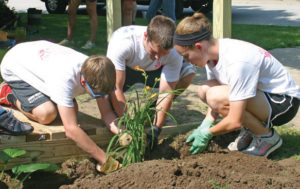Editor’s note: On Dec. 4, 1963, Pope Paul VI promulgated the Constitution on the Sacred Liturgy, known in Latin as Sacrosanctum Concilium, the first document the world’s bishops approved during Vatican Council II (1962-65). To commemorate the 50th anniversary of Sacrosanctum Concilium, The Catholic Messenger is publishing a series of articles exploring key themes of the document. This article addresses social justice.
By Father Bud Grant

“Give them something to eat yourselves.”— Luke 9:13
The Scriptures are replete with references to food and eating. There are picnics and weddings and banquets for the poor, leaven of the Pharisees, baskets of loaves and dried fish, hunger for righteousness, fatted calves slaughtered and innocent lambs slain, apocalyptic feasts of heaven.
Certain ethical norms emerge continuously in this cornucopia of meal references. Two stand out. The first is that meals are almost entirely communal events: food, it seems, is meant to be shared in common and the nourishment we derive is only partially from the calories we take in — think of the near absurd image of a lone person at a Thanksgiving table — the real satiety is to be had in companionship with others. The second is that the company ought to be inclusive. Among the archetypical sins that sizzle in Jesus’ parables is callousness to the hungry. We have “Dives” who stepped over the corpse of Lazarus at his doorstoop without a thought; woe to those who failed to see Christ in the hungry, the thirsty, the naked and the imprisoned; the revelers in wine and meat who are oblivious of the coming Judgment.
Both of these points — community and inclusivity — are made abundantly clear in the seminal reform of the liturgy of Vatican II. Even its title signals the communal nature of the Eucharist, Sacrosanctum Concilium (SC) means “most sacred gathering.” The Eucharist is to be celebrated by a community wherein we are nourished as much by the shared Word as the broken loaf (SC 51: “the treasures of the Bible are to be opened up more lavishly so that a richer fare may be provided for the faithful at the table of God’s word”). From the time of Peter on “the Church has never failed to come together to celebrate the paschal mystery” (SC 6). Indeed, it could be said that the paschal mystery cannot really be celebrated (experienced, yes, celebrated, no. c.f. SC 12) except by coming together in “full, conscious, and active participation” (SC 14) wherein “each person, minister, or lay[person] … has an office to perform” (SC 28).
And lest we think that this pertains only to the Mass, and not also to our daily lives, the Fathers of Vatican II are clear that the Eucharist “contains much instruction for the faithful” (SC 33). While it “does not exhaust the entire activity of the Church” (SC 9), “the liturgy is the summit toward which the activity of the Church is directed. It is also the font from which all her powers flow” (SC 10). This signals that the body of Christ is an inclusive community imbued with a “preferential option for the poor.”
St. Ambrose of Milan once smashed the Church plate to care for refugees. To his detractors he asserted that “the glory of the sacraments is the redemption of captives. Truly they are the precious vessels” (de Officiis II.138). St. Lawrence too, when required to submit the sacred vessels, shepherded the poor into the prefect’s chamber and said “behold, the true treasure of the Church.”
It is a breathtaking moment when the priest exhibits the consecrated host before the people and breaks it. This awful act — seemingly that of Pontius Pilate himself — must be done: it is only by Christ being broken that we are made whole.
The Eucharist is the summit and source of the Church’s life, particularly realized in the building up of the eschatological Kingdom of God (SC 8) through the service it pays to and the justice it demands for to those who are most shunned. An inclusive Church is a Church of the marginalized. We must admit, in our humility, that we are not yet the purest incarnation of the body of Christ in the world.
The Catholic Church still struggles with what it means to include the marginalized — women, illegal immigrants, heteropraxic politicians (people who fail to follow the teachings of an avowed belief system), gays, divorced and re-married — as the Holy Father, in preparation for the Synod on the Family, reminds us. So, too, does Sacrosanctum Concilium continuously reiterate that the “most sacred gathering” must be communal and inclusive, “a sign under which the scattered children of God may be gathered together until there is one fold and one shepherd” (SC 2). Who would Jesus exclude from the banquet?
(Father Bud Grant is a professor of theology at St. Ambrose University in Davenport.)








